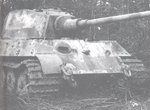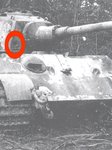schwarzpanzer
Senior Airman
- 662
- Aug 8, 2005
My, my, my Soren but you've got the knives out haven't you?
I've posted allsorts, usually my stuff is wiped off for some strange reason (the Panther vs Bazooka test being one).
Constantly quoting is boring, but if it puts someone onto something of interest to them, so be it.
You can moan all you want Soren, but I am not about to do a bibliography, I have explained when I can't get links and as I find them I will post them.
I suppose anything new should go here though, so it's nice and together - I can understand that.
- I actually attempted it before!
True, even when immobile!
You must remember that the Soviet's used different tactics - sheer weight of fire to pound an ememy and that the 122mm ammo did not work by penetration like the other nations.
The way a Soviet (and some modern British) gunner works is to simply hit a target 'till it stops moving.
I don't think you take these factors into consideration do you delcyros?
Usually a lot more HealzDevo, but like most WW2 German equipment it was not for the badly trained and/or inexperienced.
Er, the 76mm vs the 50mm 75mm L24 and the 85mm vs the L48 75mm? - I'd say it was.
True, but a silly idea really. It was also intended to combat any heavy Soviet vehicles.
I think maybe a T34/100 was used, but IIRC it was a field upgrade in 'Nam, if I find info I'll post it.
Found some info the place where the Panther Ausf F was apparently used PlanD, thought you'd like it? I'll post it shortly.
Yes delcyros, the D10 results you post are fascinating, to me at least.
I know you don't factor tungsten shells like APDS APCR/HVAP into your calculations? - Maybe you should state this more clearly?
If it's glacis wasn't hit square on?...(Spalling or crew shock etc might still result in a KO though, or allow time for a folow-up round).
I know that T34 armour spalled horrendously when hit by even a glancing blow, also the stress from a hit can affect a glacis, as can weak-points like the MG ball-mount etc.
Also if a blow drops a piece of heavy equipment previously bolted to the inside of the tank on top of you then...
Simply saying x round will not defeat x plate is going nowhere, though delcyros' calculations give a very good indication of what is a likely result.
Continuing would give a good real-world expectation of what might happen, luck is also a big factor!
German test plates may have been the best in the world, but the King Tigers armour was often sub-standard; brittle, soft and prone to spalling.
As for the King Tigers armour quality, I think 'very variable' sums it up.
Yes, I remember a Sherman's belly armour 'bent' when hit by an AT mine. KO'd the driver, but no penetration happened.
Yes, 'till APC/APCBC is factored in?
Prone to cracking too, though that would definately be ductility I guess spalling was various factors, not 1 main one (non-homogenious etc)?
Look at it this way Soren;
2 pieces of clay - 1 hard, 1 soft.
KwK43 = sharp knife
D25 = hammer
Right, you could pound the soft clay or stab it, but with the hard clay you can just shatter it or hole it, you understand?
Thank you very much for that delcyros! Good info, thanks!
The D25 was a howitzer remember, and was sometimes used that way...
I wonder Soren, some StuG's were made of mild, unhardened steel - perhaps this was what the Panther 'suffered' from and could have actually been a blessing?!
Could be down to 2 factors called skate angle or shatter gap - wet cardboard can deflect tungsten there!
Also the Panther will be firing down at the T34's glacis too, and the T34's glacis armour being only 45mm will mean shatter gap and skate angle aren't a factor.
I think that's a lie, though apparently a PaK43 did blow a T34's engine through the glacis, and quite a distance away!
Good point PlanD, but fights did sometimes get up close. These calculatons can answer questions like "at what distance could a T34/85 nail a Panther G head-on?" etc.
Too right delcyros, I too understand the importance of this.
I apologize for my many quotes, but I find this thread very interesting and just can't help myself.
I've posted allsorts, usually my stuff is wiped off for some strange reason (the Panther vs Bazooka test being one).
Constantly quoting is boring, but if it puts someone onto something of interest to them, so be it.
You can moan all you want Soren, but I am not about to do a bibliography, I have explained when I can't get links and as I find them I will post them.
I suppose anything new should go here though, so it's nice and together - I can understand that.
- I actually attempted it before!
It was still a tank to be reconed with on the battlefield despite its mechanical problems.
True, even when immobile!
You must remember that the Soviet's used different tactics - sheer weight of fire to pound an ememy and that the 122mm ammo did not work by penetration like the other nations.
The way a Soviet (and some modern British) gunner works is to simply hit a target 'till it stops moving.
I don't think you take these factors into consideration do you delcyros?
Also how much training would the German Tank Crews in their tanks like King Tiger and the rest have had in relation to the Russian Tank Crews of the T-34 and the rest?
Usually a lot more HealzDevo, but like most WW2 German equipment it was not for the badly trained and/or inexperienced.
The T-34 cannon wasn't even powerful compared to it's German counter-parts.
Er, the 76mm vs the 50mm 75mm L24 and the 85mm vs the L48 75mm? - I'd say it was.
The King Tiger was designed for the Western front, because the designers knew the weight was going to be massive and the West road networks would hold it up.
True, but a silly idea really. It was also intended to combat any heavy Soviet vehicles.
I think maybe a T34/100 was used, but IIRC it was a field upgrade in 'Nam, if I find info I'll post it.
Found some info the place where the Panther Ausf F was apparently used PlanD, thought you'd like it? I'll post it shortly.
It all belongs to the artelleristic performance of the D10. This gun was in service for several tank hunters. Nethertheless, I earlier stated that even the 85 mm D 5 of the T-34-85 will have a reasonable chance to defeat the turret front. However, running my calculators shows that it cannot do. The necessary impact velocity exceeds the muzzle velocity, but not by much (24 m/s or ~ 80 fps are missing). If we factor nose shatter, the gap widens
Yes delcyros, the D10 results you post are fascinating, to me at least.
I know you don't factor tungsten shells like APDS APCR/HVAP into your calculations? - Maybe you should state this more clearly?
These distances questioning that the JS-II had ANY immune zone vs 8.8cm KWK L71.
If it's glacis wasn't hit square on?...(Spalling or crew shock etc might still result in a KO though, or allow time for a folow-up round).
I know that T34 armour spalled horrendously when hit by even a glancing blow, also the stress from a hit can affect a glacis, as can weak-points like the MG ball-mount etc.
Also if a blow drops a piece of heavy equipment previously bolted to the inside of the tank on top of you then...
Simply saying x round will not defeat x plate is going nowhere, though delcyros' calculations give a very good indication of what is a likely result.
Continuing would give a good real-world expectation of what might happen, luck is also a big factor!
German test plates may have been the best in the world, but the King Tigers armour was often sub-standard; brittle, soft and prone to spalling.
As for the King Tigers armour quality, I think 'very variable' sums it up.
The US homogenious plates, beeing softer, could tear and therefore deflect incoming projectiles better.
Yes, I remember a Sherman's belly armour 'bent' when hit by an AT mine. KO'd the driver, but no penetration happened.
In general spoken, the lower the impact obliquity, the better the german plate in comparison, the higher the impact obliquity, the better the US plates. Sound and simple.
Yes, 'till APC/APCBC is factored in?
The Tiger I also has tough and ductile armour but the Panther, beeing tough, was prone to spalling effects and the Tiger-II armour in the end was both, soft&brittle
Prone to cracking too, though that would definately be ductility I guess spalling was various factors, not 1 main one (non-homogenious etc)?
Look at it this way Soren;
2 pieces of clay - 1 hard, 1 soft.
KwK43 = sharp knife
D25 = hammer
Right, you could pound the soft clay or stab it, but with the hard clay you can just shatter it or hole it, you understand?
Part of the problem was the unsolved hydrogenium embrittlement, not noticed by german metallurgists. A plate beeing initially ductile soon becomes brittle with a significant drop in %-elongation ability (often between 1.5 and 2.5%) due to wear of use. US plates had this problem fixed by mid 1943.
Thank you very much for that delcyros! Good info, thanks!
Now, If you factor that the angled plates of the Tiger-II ALWAYS caused high obliquity impacts
The D25 was a howitzer remember, and was sometimes used that way...
The armor quality of German tanks however went down considerably from late 44 to 45, the JagdPanther's having a frontal armor of just 200 BHN
I wonder Soren, some StuG's were made of mild, unhardened steel - perhaps this was what the Panther 'suffered' from and could have actually been a blessing?!
One particular incident comes to mind where US M36 TD's after fruitlessly having bombarded a Jagdpanther's glacis plate from 300y away had to come within 100y to knock it out.
Could be down to 2 factors called skate angle or shatter gap - wet cardboard can deflect tungsten there!
At close distance, the frontplate, despite its decent slope will be defeatable.
Also the Panther will be firing down at the T34's glacis too, and the T34's glacis armour being only 45mm will mean shatter gap and skate angle aren't a factor.
Tiger crews reported that at 1,000m (The most usual engagement range for Tiger's in the beginning), the Pzgr.39 usually tended not only to completely penetrate the glacis but also exit out the back end of the T-34 - through the engine.
I think that's a lie, though apparently a PaK43 did blow a T34's engine through the glacis, and quite a distance away!
All these calculations become worthless when the fact remains that Tigers and Panthers were hitting, and destroying the T-34 from ranges beyond which the T-34 could strike back. And this would be at any point on the T-34.
Good point PlanD, but fights did sometimes get up close. These calculatons can answer questions like "at what distance could a T34/85 nail a Panther G head-on?" etc.
just wanted to point out that BRH is not the one only metal quality.
Too right delcyros, I too understand the importance of this.
I apologize for my many quotes, but I find this thread very interesting and just can't help myself.


